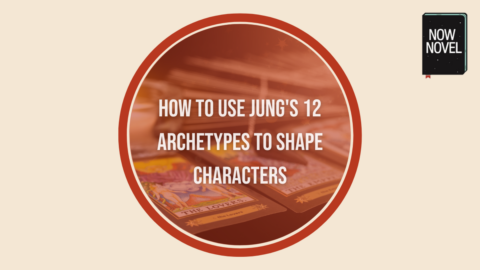We are all familiar with character archetypes: the smiling joking jester, the villain with a leer on his face, or the wise man or woman with flowing white hair.
There’s a reason we are familiar with them, as they are used over and over in the stories we watch, read and consume in various forms. It’s comforting to come across them, and we experience something of ‘a-ha’ moments when we encounter such characters. They also mimic the people we meet in real life – and some of the pleasures of reading or watching films and TV series is in seeing what we know reflected in these stories and relating or resonating with them. And that’s a good reason to use them in writing stories too.
An archetype is a character that is said to be a typical blueprint or template: and we recognise them instantly. We know that a warrior will conquer a dark force, or lead a challenge for instance. Or, that a villain is likely to upend our hero or heroine’s world, and will have evil qualities in good measure. A character archetype has a set of universally recognizable characteristics and patterns of behavior. We recognize them instantly.
We will explore the qualities of 12 archetypes, with examples from literature, film and television, and look at uses for them in fiction.
We have written previously of Jungian archetypes. Psychoanalyst Carl Jung defined 12 types of archetypes and characters and it’s these that we are going to explore in detail. Other posts which deal with archetypes include how to use story archetypes and how to enrich your story’s cast while using character archetypes.
Each archetype has its own set of values, traits, and motivations. They are broadly grouped into three categories.
The ego archetypes: the Hero, the Innocent, the Everyman and the Caregiver
The soul archetypes: the Explorer, the Rebel, the Lover, and the Creator/Artist
The self archetypes: the Jester, the Sage, the Magician/Wizard, and the Ruler
The Ego archetypes
The Hero
The hero is a fundamental character driven by a need to change the world, they embark on an adventure, undergo personal transformation or growth and vanquish adversary. The hero archetype is often found in myths, stories, and folklore across cultures.
Heroes often possess traits such as bravery, resilience, determination, and a sense of duty or morality. They may also receive aid from allies or mentors and confront antagonistic forces or villains along their journey.
Use: They can drive the plot forward, as a central character in your story and to provide a relatable figure for readers to root for.
Here is a detailed look at the hero’s journey.
Examples:
Odysseus in Homer’s The Odyssey: Odysseus undergoes a long and perilous journey home after the Trojan War, facing numerous challenges and temptations, including encounters with monsters like the Cyclops and the Sirens.
Harry Potter in J.K. Rowling’s Harry Potter series: Harry, along with his friends Ron and Hermione, battles against the dark wizard Voldemort and his followers, facing danger and adversity while discovering his own courage and strength.
The Innocent
The Innocent archetype represents purity, goodness, and naivety. Characters embodying this archetype often possess a sense of optimism, trust, and an unwavering belief in the inherent goodness of the world. They may be sheltered or inexperienced, but they have the potential for growth and resilience as they go through life.
Use: The Innocent is a pure-hearted and naive character who sees the world through a lens of optimism and trust. They can serve as a source of hope in the story, navigating through adversity with grace and good humor.
Examples:
Scout Finch in Harper Lee’s To Kill a Mockingbird: Scout is a young girl growing up in the racially divided South during the 1930s. Her innocence and curiosity lead her to question the injustices and prejudices of society. Through the novel she learns important lessons about empathy, compassion, and the complexities of human nature.
While not fiction, of course, Anne Frank in The Diary of a Young Girl is an example of innocence. Her diary entries are full of belief in the goodness of humans, despite her circumstances, being in hiding from the Nazis, as she famously writes in an entry: ‘In spite of everything I still believe that people are really good at heart.’ She grows throughout the two years of writing in her diary.
The Everyperson
The Everyperson archetype represents the ordinary individual, typically an average person who serves as a stand-in for the audience or reader, your ‘everyday Joe’. They might often be unassuming but can still play a big role in a story. They may face relatable challenges and experiences, making them highly relatable to readers. They are often used to explore universal themes and truths about human nature.
Use: This is an ordinary individual thrust into extraordinary circumstances, use them to navigate such circumstances showing how they come out at the other send and (usually) triumph.
Examples:
Winston Smith in George Orwell’s 1984: Winston is an ordinary citizen living in a dystopian society ruled by a totalitarian government. His struggles with conformity, surveillance, and rebellion against the oppressive regime reflect the fears and anxieties of many readers, making him relatable.
Bilbo Baggins in J.R.R. Tolkien’s The Hobbit: Bilbo is a humble hobbit who finds himself swept up in an epic adventure to reclaim a treasure guarded by a dragon. He shows that ordinary individuals are capable of extraordinary deeds.
The Caregiver
The Caregiver archetype is emblematic of compassion, nurturing and selflessness. They often prioritize the well-being and happiness of others above their own needs and may serve as mentors, protectors or sources of comfort and support. They are kind, empathetic, and nurturing figures who offer guidance and assistance to those who need it.
Examples:
Charlotte in E.B. White’s Charlotte’s Web. Charlotte is a spider who befriends Wilbur, a pig destined for slaughter. She uses her intelligence, spinning words in spiderwebs around him, and saves his life.
Atticus Finch in Harper Lee’s To Kill a Mockingbird: Atticus is a compassionate and principled father who serves as a moral compass for his children, Scout and Jem. As a lawyer he fights against racial injustice in the segregated South.
Use: Use them to demonstrate the power of friendship, of selflessness, and empathy.
The soul archetypes
The Explorer
They are driven to explore the world, seek new adventures whether on physical or spiritual journeys. Unlike the hero they don’t wait around for an inciting incident to set off. These characters are driven by a thirst for exploration, a desire to break free from the constraints of the familiar, and a curiosity about the unknown.
Examples:
Captain Ahab in Herman Melville’s Moby-Dick, who leads his crew on a dangerous pursuit of the elusive white whale.
Siddhartha in Hermann Hesse’s Siddhartha, who embarks on a spiritual journey to find inner peace and enlightenment.
Use: to explore the nature of universal themes and metaphysical questions and to explore new worlds, whether fantastical or real, such as a character venturing into India.
The Rebel
Rebels in fiction often represent the individuation process described by Jung, where individuals strive to become their true selves by breaking free from societal expectations and discovering their unique identity, struggling against oppression, conformity, and stagnation.
Examples:
Holden Caulfield in J.D. Salinger’s The Catcher in the Rye rebels against societal norms and expectations, seeking authenticity and autonomy in a world he perceives as phony and oppressive.
Rebels can also be heroes as is the case with Katniss Everdeen in Suzanne Collins’ The Hunger Games. She defies an oppressive regime, but she also embodies the Hero archetype as she leads a rebellion and fights for justice and freedom.
Use: They drive the main part of a story forward and are usually the main protagonists. Readers often identify with them – or might even wish to be like them! Use them to explore themes of individuality, freedom, and resistance as we as raise moral questions and dilemmas.
The Lover
The Lover archetype embodies themes of passion, romance, and deep emotional connection. Characters representing this archetype are often driven by intense desires and seek fulfilment through love, intimacy, and sensual experiences, or even close friendships.
Examples:
There are so many! There are the lovers Romeo and Juliet in the play by William Shakespeare, whose love leads to their tragic end.
In film, Titanic has Rose from the upper class of society falling for Jack Dawson, a passenger frm third-class falling for each other.
Uses: The lovers’ relationships serve as central plot elements, driving character development and emotional arcs. Love and desire can also create conflict and tension within a story, particularly when characters’ desires clash or when external forces threaten to tear them apart. Love triangles, forbidden romances, and societal barriers to love are common sources of conflict that can heighten drama and drive the narrative forward.
The Creator/Artist
The creator artist wants to create things, from books to paintings or movies and more. This is their primary drive. They are passionate about creating, sometimes to the point of ignoring other aspects in their lives. They use their imagination and originality to bring new things into the world.
Examples:
Willy Wonka from Roald Dahl’s Charlie and the Chocolate Factory is a whimsical yet visionary entrepreneur who creates fantastical candies and builds a chocolate-themed fantastical factory.
The strange but also visionary Dr Victor Frankenstein in Mary Shelley’s Frankenstein, who creates a new man out of body parts from graves, but is ultimately disappointed in his creation.
Uses: Explore the creative process with these characters, from self-expression to self-doubt (which can be a cause of tension) delve into questions of identity, use them for social commentary on their world.
Publish With Purpose
Understand the best practices of the publishing world and how to present your archetype-driven stories to the right audience. Our course equips you with the knowledge to make informed decisions for your publishing journey.
Start Learning
The self archetypes
The Jester or the Trickster
This character serves to liven up a story, bringing humor, levity and comic relief to a story. Characters embodying this archetype often possess wit, spontaneity, and a playful demeanor, using humor and satire to comment on the absurdities of life and provide insight into deeper truths.
Examples:
Lewis Carroll’s Alice’s Adventures in Wonderland has The Mad Hatter who is a whimsical and eccentric character who delights in nonsensical riddles, wordplay, and absurdity. He adds humor while also challenging her perceptions of logic and reality.
In Miguel de Cervantes’ Don Quixote Sancho Panza serves as the loyal squire and comic foil to the idealistic knight-errant, Don Quixote. Sancho provides a counterbalance to Don Quixote’s romantic idealism.
Uses: They disrupt the status quo adding unpredictability and chaos to the story, challenging the Hero in unexpected ways while adding humor and levity.
The Sage
These archetypes are the wise mentors, advisors, or guides who offer valuable counsel and guidance to the protagonist or other characters. They are associated with intelligence, foresight, and a deeper understanding of the world compared to others in a story.
Examples:
Yoda in the Star Wars films is legendary Jedi Master known for his wisdom, insight, and mastery of the Force. He serves as a mentor to Luke Skywalker, training him in the ways of the Jedi and imparting valuable lessons about the nature of the Force and the path to becoming a Jedi Knight.
In film in The Matrix, Morpheus makes Neo question his existence, and then guides him toward finding the truth.
Use: They offer guidance to the protagonist, helping to propel a story, and helping them make difficult decisions and grow through the narrative.
The Magician/Wizard
The Magician or Wizard archetype embodies mastery over mystical forces, arcane knowledge, and supernatural abilities. They are depicted as wise mentors, powerful sorcerers, or enigmatic figures who wield magic to achieve their goals. The Magician/Wizard is wise and has the ability to manifest change through supernatural means.
Examples:
Ged in Ursula K. Le Guin’s A Wizard of Earthsea is a talented young wizard who embarks on a journey of self-discovery and redemption.
Merlin n Arthurian legend is a legendary wizard and advisor to King Arthur. He playa a crucial role in Arthur’s rise to power and the establishment of Camelot.
Uses: They can propel narrative forward with their mastery over magic, introduce conflict and they can be mentors or guides to the main protagonist.
The ruler
These characters typically hold positions of power, whether as monarchs, leaders of organizations, or influential figures within their communities. The Ruler archetype is associated with qualities such as strength, wisdom, and a sense of responsibility towards those under their care. Of course, there are also villainous rulers too, who use their power in negative ways.
Examples:
In film, King T’Challa, also known as Black Panther, in the Marvel Cinematic Universe media franchise is the ruler of the fictional African nation of Wakanda. As king, he must balance his responsibilities to his people with the challenges of defending Wakanda from external threats and upholding its traditions and values.
Still looking at royalty, there’s the example of Queen Elizabeth in the TV series The Crown. Asthe monarch of the United Kingdom and head of the Commonwealth the series explores her life as she navigates the challenges of leadership, duty, and personal sacrifice. Here’s a memorable quote from the series that sums up her practical no-nonsense attitude: ‘For better or worse, the crown has landed on my head. And I say we go.’
Uses: Use to explore themes of leadership, power and responsibility. They drive the plot through their actions, show how this affects their characters and explore questions of morality.
So these are the archetypes as set out in Jung’s theory. You will notice that a villain archetype is missing. A villain is an antagonist, in opposition to the main character. However, any number of these characters can be a villain, too. The ruler could misuse their power, or the wizard too could use their powers of magic to do evil.
Other archetypes include the Sidekick: The loyal companion or assistant to the hero, offering support, comic relief, or assistance in overcoming obstacles. There’s the orphan: The character who feels disconnected or estranged from their origins or community, seeking belonging, identity, or purpose. There’s also the Femme Fatale (for example Scarlett O’Hara in Gone with the Wind by Margaret Mitchell, a seductive and mysterious character who uses her charms to manipulate others. They add intrigue and complexity to the story, often blurring the lines between ally and adversary.
There are tons more of course. Have a look at like to look at this list of 77 archetypes.
If you’re interested in how to subvert character clichés, this is a handy guide. Here more ideas on how to write great characters using archetypes.

Characterization 101
Enroll in our free 5-day email guide on characterization, and receive expert tips, exercises, and examples directly to your inbox.
Sign up for free




2 replies on “How to use Jung’s 12 archetypes to shape characters”
Please I want to use your characters in my life story book I m writing. Now I want you to admit me to use your pictures and characters in the book. Perhaps it will be printed in Sweden in the future. I hope you don´t mind me using your characters and pictures of the archetypes?
Hello Maria, thanks for your comments.
These character archetypes are freely available for you to use and adapt in your own writing. They are part of the common archetypes you find in all sorts of stories, and have been used again and again, as well as changed and adapted.
Glad you found this useful and all the very best with your own writing!